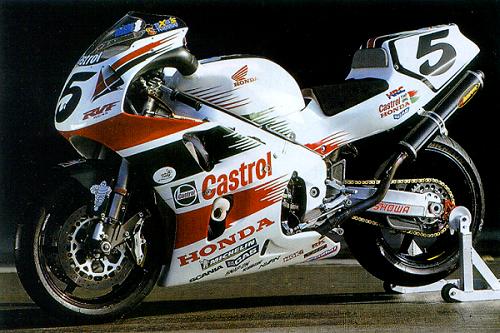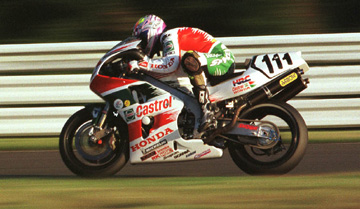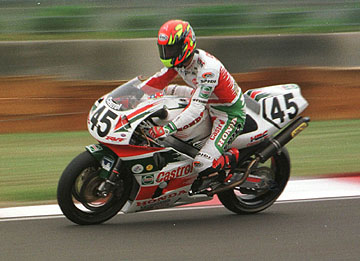World Superbike Honda RVF750 (RC45)

Colin Edwards' 1999 RC45. Sadly retired at the end of 1999 - the end of an era. Photo © Koichi Ohtani
Alan Cathcart is a respected racer who has the privilege of being able to test all the top race machines for public consumption. This highly envied position allows him to give readers an insight into the real differences between makes, and even between years. This is revealed in his articles for Motorcycle Racer magazine, among others. Below are some of the salient comments on Colin Edwards' 1999 World Superbike RC45, when Alan was given the chance to test it at the end of the 1999 racing season.
Ever since the debut of the oval-piston NR500 at Silverstone in August 1979, Honda has made the V4 engine format its corporate engineering trademark. A best-selling range of streetbikes has been developed around a mechanical architecture uniquely their own. The succession of title-winning racers, in most cases, were derived from the models customers could buy in the showroom. The result has been a plethora of world and national-level championship crowns won over the past 20 years by Honda's signature V4s, from Mike Baldwin's 1982 US Formula 1 title aboard the meaty 1084cc FWS prototype, up to Doug Polen and Christian Lavieille's 1998 World Endurance crown on the RC45.
This must be the easiest world-level race bike in any class to ride in the rain. That's thanks to the smooth, progressive power delivery. It comes in from as low as 6,000rpm, a controllable transition into hyper-strong power from 12,000 revs upwards, when the needle on the analogue tacho (sorry: traditional, old-fashioned - but still much easier to read under racing conditions than the digital infocentres such as Suzuki and Ducati use) moves irresistibly into fast-forward mode. There's none of the brusque, jerky throttle response in any gear when you get on the gas again from a closed throttle. Even when you get the back wheel slithering around, it all feels so controllable.
The next day shone, and it was time for a track test I'll always remember. That's not just because I ended up doing a lap time that brought smiles and compliments from HRC race staff, but because of the qualities of the bike I did it on - arguably the finest Superbike I've yet ridden. And, yes - this was less than a month after I'd ridden Carl Fogarty's world champion Ducati, so I do have a valid basis for comparison.
They practically had to stand out on the track in front of me to get me to stop riding the Honda. This two-wheeled work of Oriental art is sadly headed for the Collection Hall at Motegi. As the last person to ride the last of the V4 Honda line, I have to sat I think this is a tragedy. OK - the RC45 took time to come good, but it did achieve Honda's aim of winning the World Superbike title, quite apart from all those Endurance races including the 8 hours. If Suzuki or Kawasaki, let alone Aprilia or any European company, had developed a Superbike to this level of competitiveness, the last thing they'd be thinking of doing now would be to send it to the corporate museum.
Honda's engineering policy throughout the company's 50 years of existence, has always been to do things differently - to do it the Honda way. In racing terms that meant a glorious succession of unique 4-stroke GP bikes throughout the sixties, when almost all others used 2-strokes. Nobody else built five- and six-cylinder GP racers, or dohc twins, only Honda. Who else but Honda could have built the oval-piston NR500, forerunner of the round-piston V4 racers now set for the history books? Who else could have won the 500cc world title for the first time with a V3 2-stroke triple against everyone else's fours, or to follow up with the only single-crank 500cc V4, when everyone else uses twin-crank designs?
The Honda Way is to do things differently, and to do them right, and on that basis I'll side with those who say that it's a great pity the next Honda Superbike for the new millennium isn't a state-of-the-art Evo V4, rather than a V-twin that can only ever aim at being a better Ducati. Because my ride on Colin Edwards' RC45 was not only the end of an era, it was also an indictment of the current World Superbike regulations. Honda is in the business to win races and titles, and to allow their customers to do the same. If they've decided that the Superbike rules are so indelibly rigged in favour of 1000cc V-twins that have to build one themselves and so deprive race fans around the world of a key ingredient of the rich variety in a Superbike grid, then that's a real pity.
© Alan Cathcart, 2000. Extract from an article that appeared in the April 2000 issue of Motorcycle Racer magazine, reproduced here with permission.
RC45 bows out in Japan
Makoto Tamada won the showpiece final race of the Japanese superbike championship at Motegi in the last competitive appearance for the RC45, in November '99. 500GP rider Tadayuki Okada was third behind Suzuki's WSB star Yukio Kagayama. Meanwhile Wataru Yoshikawa won the Japanese title for Yamaha on his R7. Meanwhile Honda Britain presented Joey Dunlop with an RC45 after the 1999 TT to mark his achievements.Current regulations mean that twin cylinder machines can be up to 1000cc in capacity, while 4-cylinder bikes have a limit of 750cc. While the 750cc bike, in particular the RC45, make as much if not more peak power than the V-twins, the advantage in acceleration out of a corner more than makes up for it. WSB regulations are set to change in 2004, when there will be a blanket 1000cc limit for all engine configurations. It is thought that Honda are now working on a 1000cc V4.
Four-strokes of varying configurations are now allowed into GPs. Suzuki has a v4, and Ducati has announced its v4-engined "Desmosedici". Read more on the MotoGP page.
Read about Julian Ryder's definitive book about the Honda V4 motorcycle family.
World Superbike Honda RVF750 specfication
| Castrol Honda RC45 (1997) | |
|
Engine type Bore & stroke Compression Ratio Fuel system Power Front suspension Rear suspension Front Brakes Rear Brakes Front tyre Rear tyre Wheelbase Rake / Trail Dry weight |
749cc 4 stroke V4 72 x 46mm 12.8:1 Keihin PGM-F1 fuel injection 160bhp @ 14,000rpm (claimed) Showa 47mm upside-down telescopic forks Showa single-sided swingarm Brembo 2 x 320mm discs with 4-piston calipers Brembo 1 x 190mm with 2-piston caliper 120/60 x 17 180/67 x 17 1400mm 24.5° / 86-98mm 162kg |
Castrol Honda RC45s in action at Sugo, 1998

Aaron Slight, photo © Rick Williamson

Colin Edwards, photo © Rick Williamson
RC45